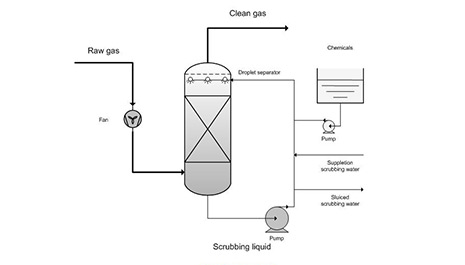Importance of Maintaining your Sewer System
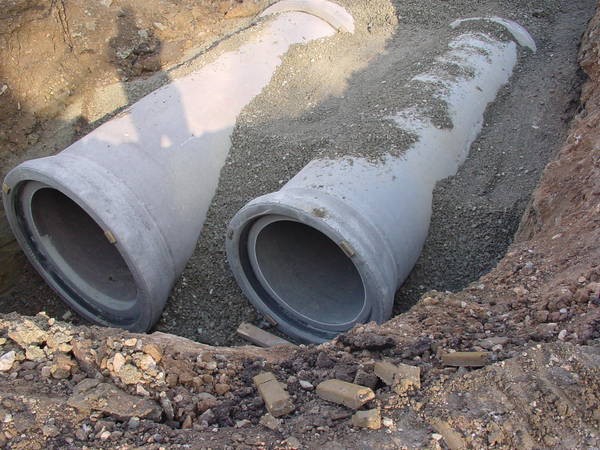
As a homeowner, you are responsible for maintaining your sewerage system. It is one way of protecting your investment while at the same time protecting the public from sanitation health hazards. A properly constructed sewage system can give you long-term and efficient treatment of wastewater in your home.
Poor sewerage system design can lead to many problems. You should also know that replacing a faulty sewer system will cost you thousands of dollars. A malfunctioning system can also contaminate underground water, which might be the source of drinking water. A faulty sewerage system also affects your home's resale value.
You should make sure that you have an accurate drawing which shows the location of the sewage system. It makes it easier for the maintenance provider to locate them and solve the problem quickly.
It is advisable as a homeowner to have a contract with the person who installed the system to set up an annual service contract. Apart from annual inspections, the system should also undergo servicing every 2 to 5 years, depending on the daily sewage flow and the number of people using the system.
When arranging for sewage system servicing, you should consider the following:
- Hire an authorized person
- Do not completely scrub the septic clean. Leave a small quantity of sludge to renew bacterial activity
- Schedule the maintenance for spring instead of fall. It will prevent solid waste from leaving the tank during winter months
4 Things You Can Do to Maintain your Septic Tank
- Care for your drain field
- Use water efficiently
- Do not dispose of hazardous wastes in toilets or sinks
- Pump the tank and inspect the system regularly
Components of Sewerage System
Sewerage systems for homes are made up of several components. There is the pipe from the house, a septic tank, a drain field, and soil. The microbes in the soil play a crucial role in the wastewater treatment process because it removes or digests contaminants from the wastewater long before it reaches groundwater.
A pipe from the House
It is the one through which all the wastewater from your home goes through on its way to the septic tank.
Septic Tank
A septic tank is a watertight container normally made of polythene, fiberglass or concrete. A septic tank is always underground. The main purpose of a septic tank is to hold the wastewater long enough for the solids to settle out and form sludge, grease, and oil and float to the surface.
It floats to the surface as scum. The septic tank also allows for the partial decomposition of the solid elements in wastewater. Inside the septic tank is a T-shaped outlet and compartments which prevent the scum and the sludge from leaving the tank and flowing towards the drain field.
You can also use screens to prevent the solids from leaving the septic tanks. Newer tanks have risers which have lids on the ground level. They make it easy to locate the tank, thus allowing efficient inspection and pumping of the tank.
Drainfield
When wastewater leaves the septic tank, it proceeds to drainfield for more treatment by the soil. The process repeats itself every time new wastewater enters the septic tank. If the drainfield is overloaded, sewage flows to the ground level. Therefore, it is advisable to have a reserve drainfield in case the current one fails.
Soil
Wastewater in the drainfield percolates into the soil. The soil treats the water by removing harmful nutrients, bacteria, and viruses.
Why you should maintain your Sewage System
Poorly designed sewage systems are a threat not only to human health but also pollute the environment. Here is why you should maintain your sewer system:
- Save money – saving money is the most important reason for maintaining your sewerage system. A failing sewage system is expensive to replace or repair.
- Protect health and environment – maintaining your sewer system plays a big role in preventing the spread of waterborne diseases as well as guarding water resources.
Types of Sewerage System
There are several groups of sewage systems. The groups include:
- Combined system
- Separate system
- Partially separate system
A combined system is where there is only one set of sewers which carries both stormwater and sanitary sewage.
A separate system is where the industrial sewage and domestic sewage share the same sewer system, and on the other hand, storm and surface water use a different set of sewers.
On the other hand, in a separate system, some of the stormwater is allowed to enter the sewage lines carrying the sewage. The rest of the stormwater continues in a separate set of sewers, known as a partially separate system.
Separate System
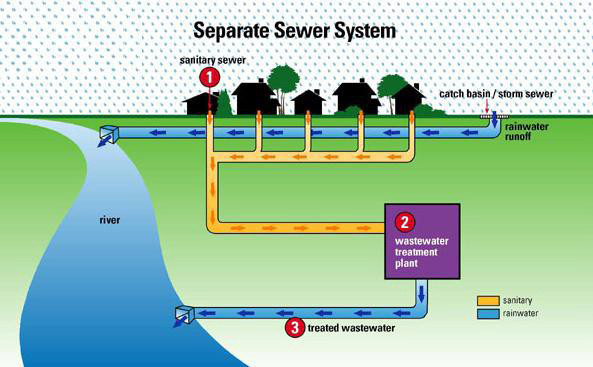
There is an economic angle because the quantity of water treated is small. It is because the wastewater flows in a separate sewer thus the treatment design is less expensive
Compared to the combined system, a separate system is cheaper because only sanitary sewage flows into closed sewers while stormwater, which is not foul, flows through open drains or gutters.
If there is need to dispose of the sewage, the separate system is cheaper
The separate system has no effects on stream pollution
Combined System
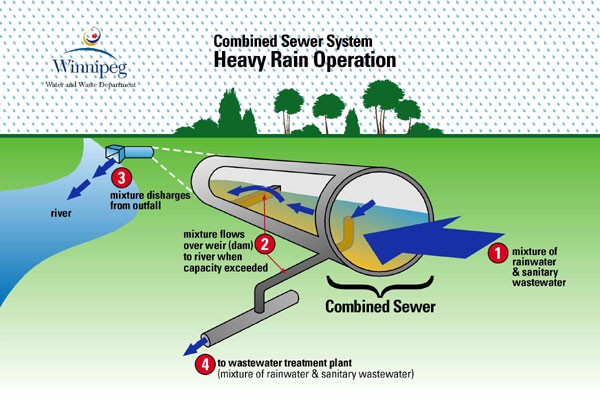
Because of the high quantity of sewage, there is high velocity which brings about an effect of self-cleansing thus eliminating the need of flushing
The sewage is usually diluted by rainwater which makes it easy and economical to treat the wastewater
The system requires one set of pipes which simplifies house plumbing
Partially Separate System
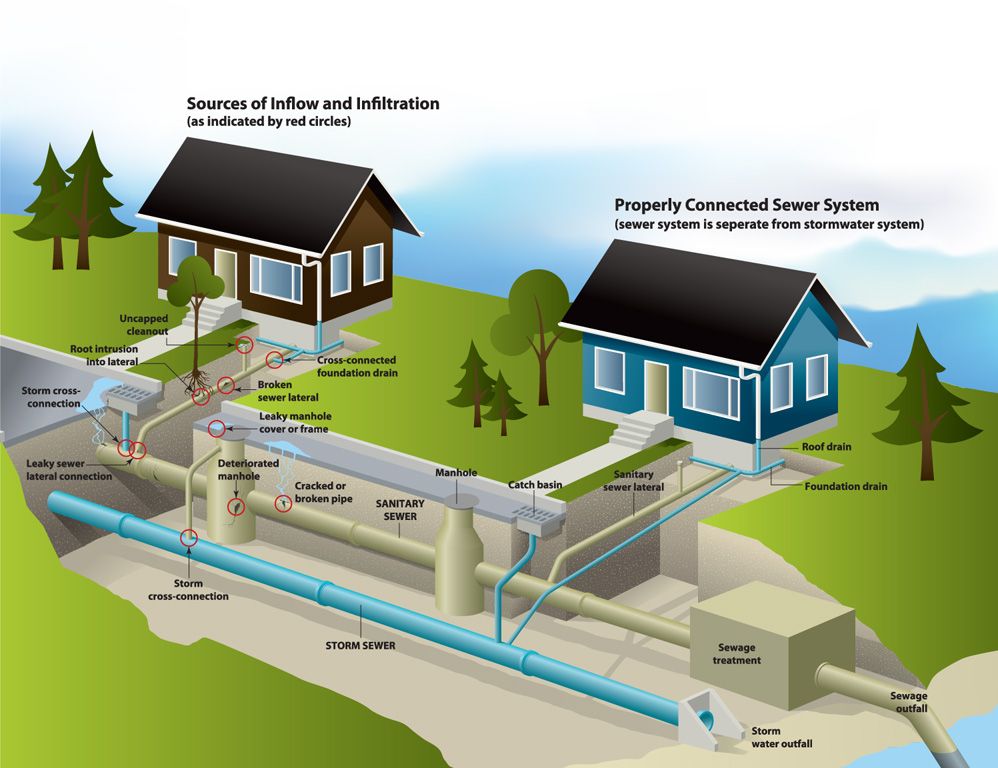
A partially separate system is an improvement over the separate system. It is a feature which makes it economical and smaller sized sewers will work just fine
The partially separate system reduces house plumbing because it enables sullage from kitchens and baths as well as the rainwater from the roof is taken using the same pipe carrying discharge water from the closets. Water from all other places goes in separate drains or sewers.
Allowing a small portion of stormwater into the sanitary sewage increases the quantity of sewage thus eliminating the need to flush.
How to maintain your Sewerage System
There are many things you can do to make sure that your sewage system is functioning properly.
Inspect and Pump Regularly
You should have your tank inspected regularly. The assessment should take place at least every three years, and you should contact a professional to do the inspection. You should also ask for a professional opinion on when you should pump the tank
There are tanks which have electrical float switches, pumps, and other mechanical components. Such tanks need an inspection on an annual basis. The inspection generally entails checking for leaks as well as checking the sludge and scum layers in the septic tank.
If the scum level is within 6 inches of the outlet tee or top of the sludge layer is within 12 inches of the outlet tee, then you should pump the tank. When an inspection is taking place, you should note the levels of the scum and the sludge. Be sure to keep those records.
Factors that Influence the Frequency of Pumping:
- Number of people in the household
- Amount of wastewater generated
- The volume of solids in the wastewater
- Size of the septic tank
Efficient Use of Water
The more a household conserves water, the less the amount of water that enters the sewage system. Using water efficiently improves how the septic system operates. Here are ways to use water efficiently:
- Use high-efficiency toilets – Toilets use at least 30% of household water. Traditional toilets use more water compared to modern toilets. If your system is flooding, you should replace the toilet with high-efficiency models.
- Faucet aerators – They help in reducing water use and also reduce the volume of water entering the septic system. Shower flow restrictors also play a big role in reducing water use.
Check the Drains
Whatever goes down the drain affects how your septic system works.
Waste Disposal
If you want your septic system to work well, there are some things that you should not flush down the toilet. Some of those items include feminine hygiene products, dental floss, cotton swabs, diapers, condoms, cigarette butts, paper towels, cat litter as well as kitchen and bathroom items which can clog and damage the septic system.
Household chemicals can also place stress or even destroy biological treatment processes in the tank.
Washing Machines
You should not overload the washing machine. Putting small loads at a time reduces wastage of water. Doing all laundry in one day can save time, but it can harm your septic system. Try to spread laundry tasks over a period to give the septic tank enough time to treat the wastewater.
Take Care of the Drainfield
Here are a few things that you should do to maintain your drainfield:
- Plant grass over and near the septic system, roots might destroy the system
- Never drive or park vehicles over the system
- Keep roof drains and other things that might flood the system away from the drainfield
Conclusion
It is important to maintain your sewage systems. Always being alert is important in maintaining the system. It will save you money and as well as maintain public health and protect the environment.
You can leave your comments on how to manage and maintain your sewage system.






